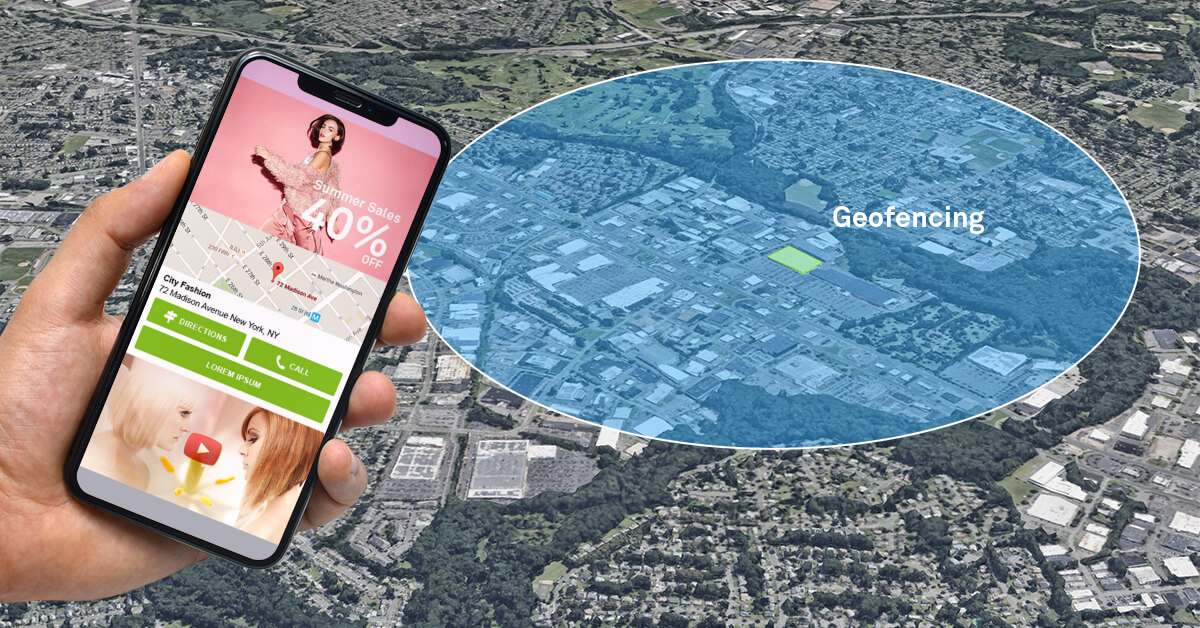Geofencing allows brands to understand how their customers behave in the physical world, how often they visit the neighborhoods where their stores are located, and how long they stay in those areas.
All of this amounts to critical customer insight that can create a better advertising experience for your customers and give your brand a competitive edge. Let’s first look at a geofencing definition, and then we’ll explore how geofencing technology can help mobile marketers.
What is Geofencing?
Geofencing works by creating virtual geographic fences around physical locations for more targeted mobile advertising.
“Geofencing (also known as “mobile geofencing”) is the application of defining a set geographic perimeter around a location. Oftentimes the output of this method is to prompt an advertisement based on location data signals derived through a mobile phone. These alerts are triggered when a mobile device enters the radius around a pre-established point of interest on a map and users have opted into the app’s location services.
Geofencing is most often used in advertising to send an ad to a user through an app. This can be in the form of a promotion, sale or a simple reminder to drop in. Marketers can even create a geofence around a competitor’s location so a customer will receive an ad when they get close to their store. This type of geofence is called geo-conquesting.”
How Does Geofencing Help Marketers?
Geofencing enables marketers to produce mobile adverts that appeal to specific demographics within a specific area or location in order to successfully deliver services or products.
Increasingly, brands are looking to geofencing technology to help them create more targeted and effective mobile ads. Geofencing isn’t particularly new, but as brands have evolved their mobile advertising strategies to better reach potential customers wherever they are, this marketing tool has become invaluable.
In 2021, mobile ad spending topped $295 billion — an increase of 23% year over year — and it’s expected to surpass $350 billion in 2022. Statista also predicted that in 2021, all US industries invested more than 50 percent of their digital advertising dollars in mobile.
Geofencing vs Geolocation
By leveraging geolocation — the geographical location of devices connected to the Internet — geofencing allows marketers to create virtual boundaries around brick-and-mortar business locations (geofences), and deliver mobile ad messages when consumers enter them.
The ultimate objective of geofencing, meaning its primary use, is to provide value through mobile advertising. One of the best ways to do that is by sending messages that are immediately useful to consumers. WiFi and GPS are used to alert marketers when a mobile device enters the defined perimeter. The location data signals then trigger an email, text, app, or media ad notification.
For the consumer, all of this results in some form of promotion, like a sale or a simple reminder to drop by a nearby store. The location-specific message is relevant to where the consumer is at that very moment, which enables your potential customer to take immediate action.
In short, with geofencing you can:
- Target a hyper-specific area
- Deliver relevant media
- Eliminate waste by targeting specific areas
- Reach customers in real-time
Now that you understand the benefits of geofencing for your brand, let’s look at why it’s so popular.
The Time is Now
Consumers are increasingly comfortable volunteering personal data such as their location with brands. According to customer experience management company Merkle’s 2021 Consumer Experience Sentiment Report, only 23% of surveyed consumers are now opposed to sharing their personal information, regardless of the benefit.
In 2020, 27% of consumers said they were comfortable sharing their location with companies, but that number jumped to 33% in 2021. According to Merkle, “Comfort levels are increasing with respect to consumers providing their data in exchange for more personalized experiences” — which presents a big opportunity for brands.
How Geofencing Works
Imagine your marketing goal is to increase foot traffic to your newest restaurant location. You can use mobile geofencing to set up a boundary around the neighborhood in which your business is located. When consumers enter that virtual fence, you can serve them a mobile ad for your restaurant, along with your address and an exclusive offer or limited-time discount. You can even encourage users to download your mobile app and peruse your menu or additional deals.
Whether you’re launching a new menu item, promoting a seasonal special, trying to increase your lunch business, or simply trying to expose more locals to your restaurant, geofencing empowers you to achieve your mobile marketing objectives. Its value extends to retailers, big box chains and department stores, coffee shops, grocery chains, and virtually any kind of physical business. Setting up a geofence around the boundaries of a mall, for example, can be useful when you want to attract customers to a sidewalk sale or alert them to a new store opening. Once mobile users enter your predetermined boundary, you can serve them that targeted messaging.
Using Geofencing to Beat Your Competitors
The advantages of geofencing aren’t limited to brand and product promotion. This same technology can also be used to create a geofence around a competitor, so that a customer receives an ad for your business when they get close to your competitor’s store.
The objective here is to persuade them to come to your business rather than go to a rival’s. If a customer is nearing a competing clothing retailer, for example, you can serve them a product coupon for your store and remind them that it, too, is just steps away. This type of geofencing, is an ideal way to drive foot traffic to your business.
Geofence Radial Targeting
Geofences can either be dynamically generated around a point location, or applied using a predefined set of boundaries. Accuracy is vital when it comes to all forms of geofencing. But not all geofencing is created equal.
Radial Targeting, perhaps the most common form of geofencing technology, can only be precise if the address around which you create your circular radius is accurate as well. Something to note about radial targeting is that it requires the user to activate their location settings.
What is Geofencing Used For?
What does the future of geofencing hold for marketers? Watch for increased personalization. One of the key advantages of this technology is that it facilitates the creation of customized ads built around consumers’ immediate circumstances.
When a consumer crosses the virtual boundary, the opportunity to personalize ad messaging begins. This kind of targeting is increasingly timely and important. Why? According to McKinsey & Company’s Next in Personalization 2021 Report, 71% of consumers expect companies to deliver personalized interactions, and 76% get frustrated if they don’t.
The ability to cater your messaging to your audience’s real-time needs by offering discounts and promotions related to their physical location is invaluable when it comes to providing a satisfying digital marketing experience. The more marketers tailor their call to action to consumers’ interests and needs, the better your odds of boosting acquisition and retention rates, building loyalty, and increasing affinity with your brand.
GroundTruth’s Mobile Geofencing Technology
At GroundTruth, geofencing takes the form of our proprietary Blueprints platform, which maps the real world in a virtual environment with maximum accuracy and precision. Blueprints is the foundation of all products and tactics developed at GroundTruth, and the means through which we’re able to provide context to the location data received in an ad-request for the purposes of audience profiling and attribution.
Our geofencing technology validates the accuracy of location boundaries with a high degree of confidence. In fact, it’s much more accurate at defining business boundaries and polygons (think store walls, parking lots, shopping centers, and other points of interest) than other industry solutions that use radius fences around a business.
In other words, the accuracy of our Blueprints can help you reach key audiences with precision to create far more effective mobile campaigns. Learn more about our geofencing marketing platform, and contact us to get started.
Summing Up
We hope that this guide has lent you a hand in understanding what geofencing is and why it’s important. It’s true that there are immense benefits of geofencing for marketers – especially in how geofencing helps create more targeted, effective mobile ads for businesses. Don’t forget: geofencing advertising is the future – use geofencing technology to beat your competitors and keep ahead of the game.
GroundTruth’s Blueprints technology is the best place to start and we’re here to help! So, what are you waiting for? Now that you’re a geofencing expert, activate your mobile geofencing campaigns and start reaching the right audiences for your mobile campaigns.






